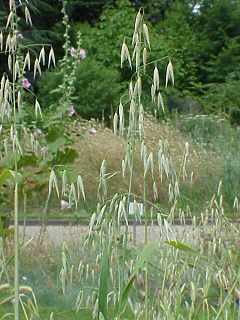
Avena is a genus of Eurasian and African plants in the grass family. Collectively known as the oats, they include some species which have been cultivated for thousands of years as a food source for humans and livestock. They are widespread throughout Europe, Asia and northwest Africa. Several species have become naturalized in many parts of the world, and are regarded as invasive weeds where they compete with crop production. All oats have edible seeds, though they are small and hard to harvest in most species.

Alopecurus, or foxtail grass, is a common and widespread genus of plants in the grass family. It is common across temperate and subtropical parts of Eurasia, northern Africa, and the Americas, as well as naturalized in Australia and on various islands.

Arrhenatherum, commonly called oatgrass or button-grass, is a genus of Eurasian and North African plants in grass family.
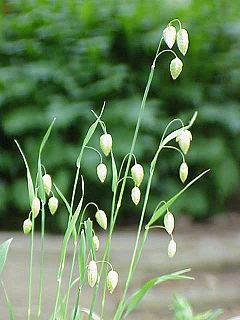
Briza is a genus of annual and perennial plants in the grass family, native to northern temperate regions of Eurasia, North Africa, and certain islands in the Atlantic.

Barthélemy Charles Joseph Dumortier was a Belgian who conducted a parallel career of botanist and Member of Parliament.
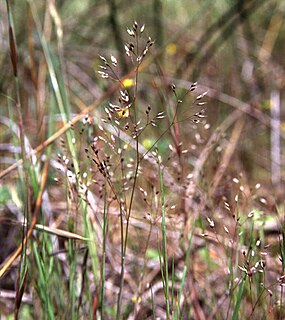
Aira is a genus of Old World plants in the grass family, native to western and southern Europe, central and southwest Asia, plus Africa.

Cenchrus is a widespread genus of plants in the grass family. Its species are native to many countries in Asia, Africa, Australia, the Americas, and various oceanic islands.

Aristida is a very nearly cosmopolitan genus of plants in the grass family. Aristida is distinguished by having three awns (bristles) on each lemma of each floret. The genus includes about 300 species found worldwide, often in arid warm regions. This genus is among those colloquially called three-awnswiregrasses, speargrasses and needlegrasses. The name Aristida is derived from the Latin "arista", meaning "awn".

Andropogon is a widespread genus of plants in the grass family, native to much of Asia, Africa, and the Americas as well as southern Europe and various oceanic islands.

Helictotrichon sempervirens, the blue oat grass, is a species of flowering plant in the true grass family, Poaceae, native to central and southwest European grasslands. It is a bunchgrass often used as an ornamental grass in garden design and landscaping.

Danthonia is a genus of Eurasian, North African, and American plants in the grass family. Members of this genus are sometimes referred to as oatgrass, but that common name is not restricted to this genus. Other common names include heathgrass and wallaby grass. Australian species have since been reclassified into the genera Austrodanthonia and Rytidosperma.

Helictotrichon, or alpine oatgrass, is a genus of perennial flowering plants in the grass family. The genus name comes from the Greek heliktos meaning twisted, and trichos meaning spine, referring to the shape of the awn.
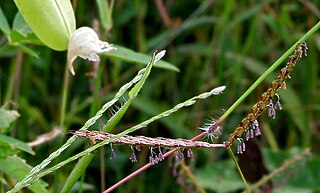
Ischaemum is a genus of plants in the grass family, widespread in tropical and semitropical regions in many countries. Many species are known commonly as murainagrass.
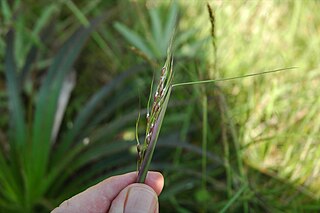
Piptochaetium, or speargrass, is a genus of New World plants in the grass family, native to North and South America. Piptochaetium is a bunchgrass genus in the tribe Stipeae.
Chamaeraphis is a genus of Australian plants in the grass family. The only recognized species is Chamaeraphis hordeacea, found in Queensland and Northern Territory.

Trisetum is a genus of plants in the grass family, widespread in temperate, subarctic, and alpine habitats in much of the world. Oatgrass is a common name for plants in this genus.

Desmazeria is a genus of Mediterranean plants in the grass family, related to Catapodium.
Henrardia is a genus of Asian plants in the grass family.

Helictotrichon pratense, known as meadow oat-grass, is a species of perennial grass in the family Poaceae, found in temperate parts of Europe, North Africa, and Asia. Its culms are erect and 30–85 cm long; leaves are mostly basal. It is restricted to shallow, calcareous soils such as those formed on chalk and limestone substrates.
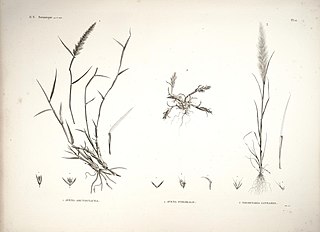
Trisetaria is a genus of plants in the grass family, native to Asia and to the Mediterranean region.


















